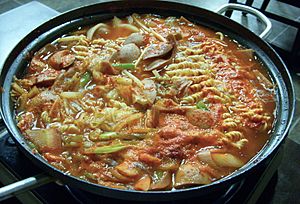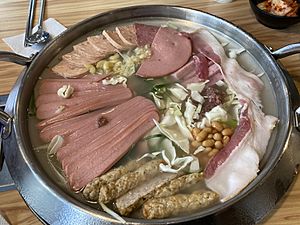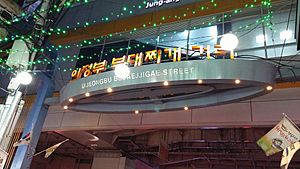Budae-jjigae facts for kids
 |
|
| Alternative names | Sausage stew, Army stew, MRE |
|---|---|
| Type | Jjigae |
| Place of origin | South Korea (with American influence) |
| Region or state | Uijeongbu |
| Associated national cuisine | Korean |
| Main ingredients | Ham, hot dogs, Spam, baked beans, kimchi, instant noodles,gochujang, American cheese |
| Korean name | |
| Hangul |
부대찌개
|
|---|---|
| Hanja |
部隊찌개
|
| Revised Romanization | budae-jjigae |
| McCune–Reischauer | pudae-tchigae |
Budae-jjigae (부대찌개), also called "army base stew" or "spicy sausage stew," is a popular Korean dish. It is a type of jjigae (stew) made with ingredients like ham, sausage, Spam, baked beans, kimchi, instant noodles, and gochujang (Korean chili paste).
This unique stew was first made shortly after the Korean War ended. People used extra food from U.S. military bases. Even though it started during a time when food was hard to find, Budae-jjigae stayed popular. Today, it is a favorite comfort food in Korea. Many restaurants specialize in this dish, especially on Budae-jjigae Street in Uijeongbu, where the stew is said to have begun. Koreans often enjoy it cooked right at the table in a big pot.
What Does Budae-jjigae Mean?
The name Budae-jjigae has a special meaning.
- Budae (부대; 部隊) means "military unit" or "troop." It can also refer to a military camp.
- So, gun budae (군부대; 軍部隊) means "military camp."
- Migun budae (미군부대; 美軍部隊) specifically means "U.S. military camp" or "U.S. military base."
- Jjigae (찌개) is a Korean word for a thick soup or stew. It is usually thicker than a regular Korean soup called guk.
Putting it together, Budae-jjigae literally means "army base stew."
How Budae-jjigae Began
After the Korean War ended in 1953, food was very scarce in South Korea. People living near U.S. army bases, especially in areas like Uijeongbu, Pyeongtaek, and Munsan, found ways to use extra food from these bases. This extra food often included processed meats like ham, hot dogs, and Spam. These were sometimes called budae-gogi (부대고기), meaning "army base meat."
At first, Budae-jjigae might have been a simple stir-fried dish. It used ingredients like canned pineapples, cabbages, onions, American cheese, and other meats. This early version was sometimes called 'ggulgguri-juk’ (꿀꿀이粥), which means "piggy porridge." Later, people started adding anchovy broth, gochujang (chili paste), and kimchi to create the spicy stew we know today. These American food items were not always easy to get. Sometimes, they were bought from unofficial markets.
Budae-jjigae is still very popular in South Korea. Today, people add many different ingredients to it. These can include baked beans, Vienna sausage, bacon, tofu, pork, ground beef, instant noodles, macaroni, tteok (rice cakes), American cheese, mozzarella, and various vegetables like minari, scallions, chili peppers, garlic, and mushrooms.
The city of Uijeongbu is especially famous for its Budae-jjigae. It is located near Seoul and has many army bases. In the late 1900s, Uijeongbu tried to change the dish's name to Uijeongbu-jjigae. This was to remove the connection to the military or wartime. However, most restaurants still use the original name. Some places now call it Uijeongbu-budae-jjigae. There's even a special "Uijeongbu Budae-jjigae Street" where many restaurants serve this dish.
What is Johnsontang?
A special type of Budae-jjigae developed near a U.S. military base in Yongsan-gu, Seoul. This version is called Johnsontang (존슨탕), which means "Johnson soup." It got its name from United States President Lyndon B. Johnson. It is said that he really enjoyed the taste of this dish when he visited Korea.
See also
 In Spanish: Budae jjigae para niños
In Spanish: Budae jjigae para niños



